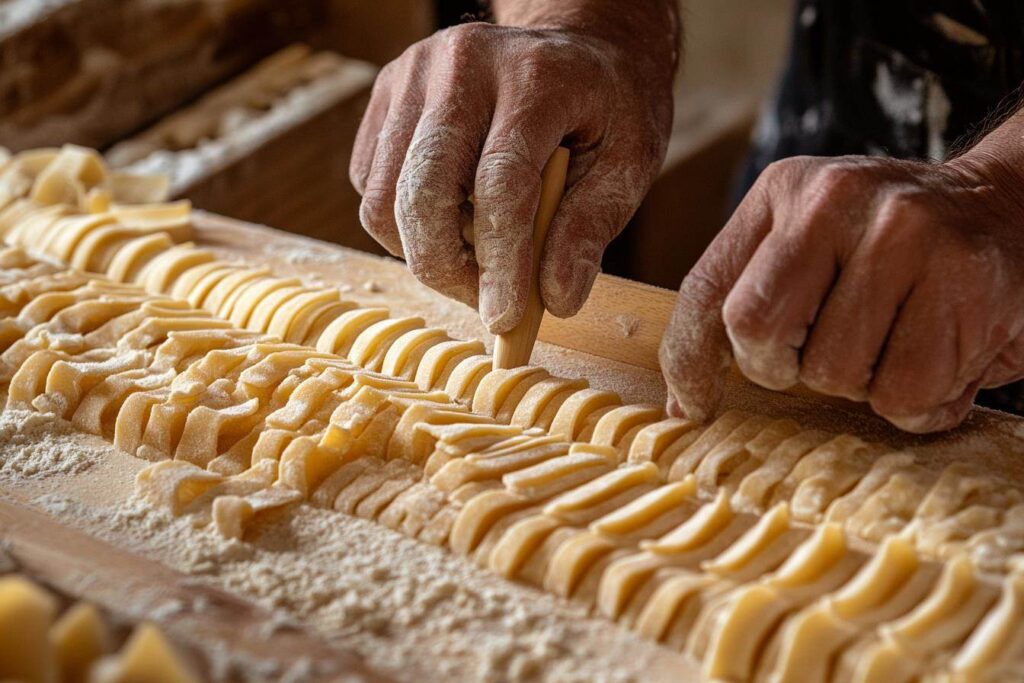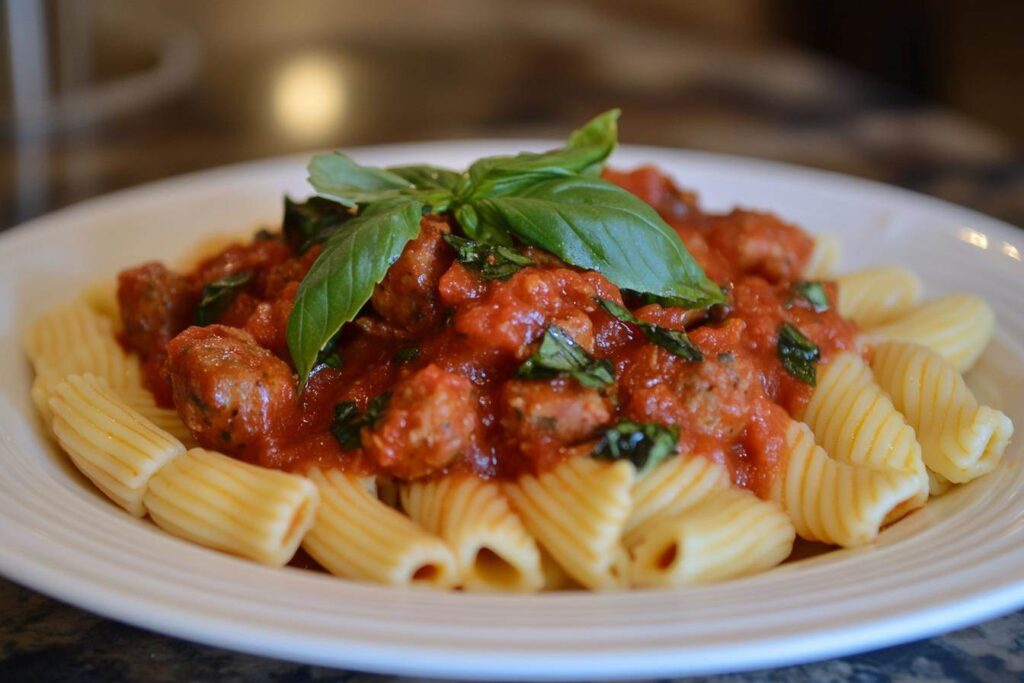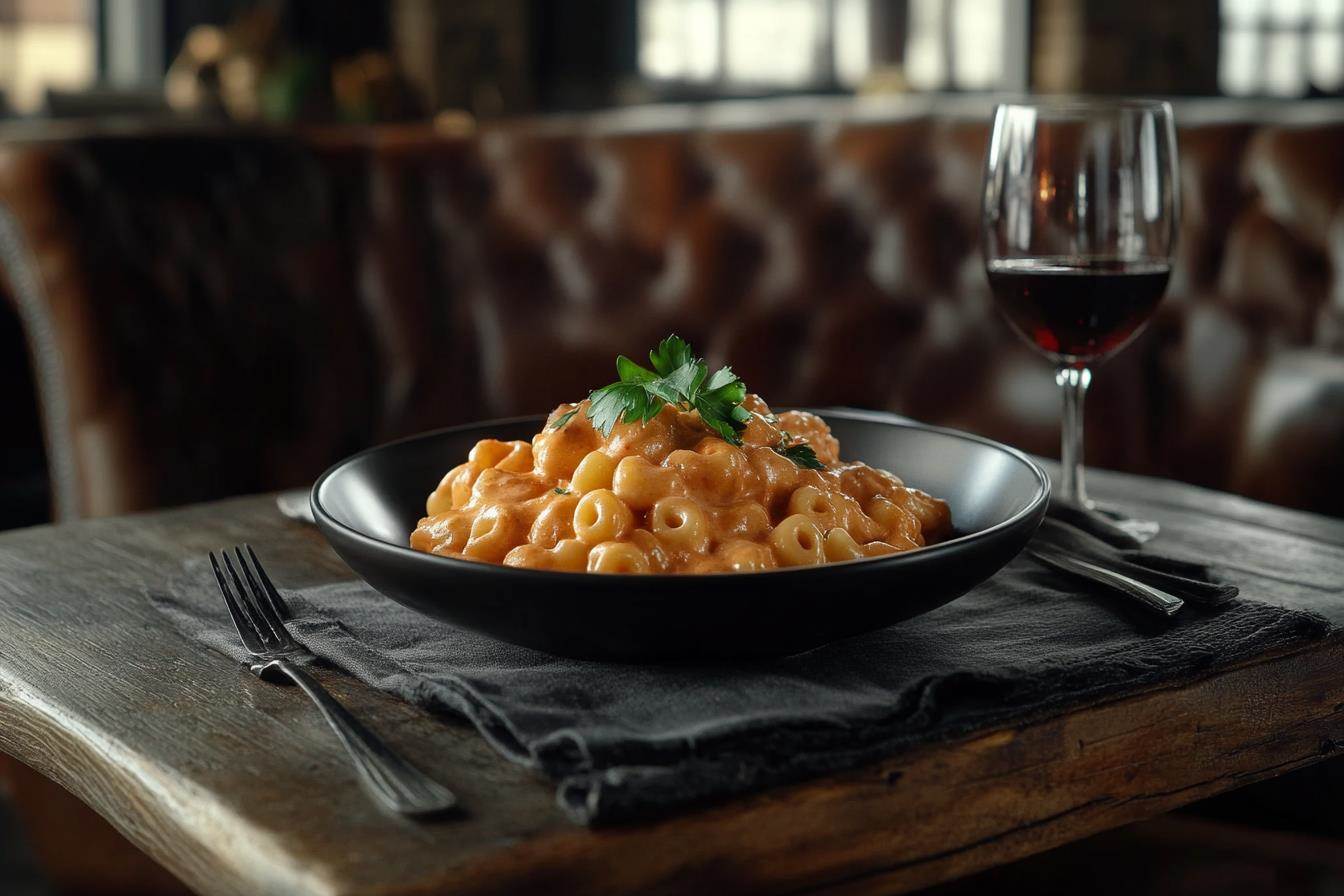Introduction to Garganelli Pasta
What is Garganelli Pasta?
Garganelli pasta is a handmade delicacy featuring tubular ridges, which are created by rolling pasta squares over a comb. Not only do these ridges add texture, but they also help sauces stick, enhancing the flavor in every bite. Moreover, it is made using just flour, eggs, and a pinch of salt. The dough is carefully rolled, cut, and shaped by hand, which beautifully showcases the creativity and ingenuity of Italian cooking.
Why Garganelli Pasta is Unique
What sets garganelli pasta apart is its versatility. Its firm texture and ridged surface allow it to pair beautifully with both creamy and hearty sauces. This adaptability makes it a favorite in Italian kitchens and a standout in gourmet recipes.
History and Origins of Garganelli Pasta
The Origins of Garganelli Pasta
Garganelli pasta traces its origins to the Emilia-Romagna region of Italy, which is often regarded as a culinary paradise due to its dedication to artisanal food. Furthermore, this area, commonly known as the “breadbasket of Italy,” has a long-standing tradition of handcrafted dishes that celebrate both simple ingredients and exceptional techniques. Interestingly, garganelli emerged as a clever solution for leftover pasta dough, providing home cooks with a way to transform scraps into something both elegant and delicious.
The name “garganelli” is derived from the word garganel, meaning “gullet” in the local dialect, which clearly references the tubular shape of the pasta. Moreover, this design wasn’t just about aesthetics—it also served a practical purpose, as the ridges helped sauces adhere to the pasta, enhancing every bite. In Emilia-Romagna, garganelli was typically served with regional specialties like ragù alla Bolognese or creamy butter-based sauces, which made it a cherished staple in Italian households.
Influence of Italian Culinary Traditions
Italian cooking focuses on using what’s available, and garganelli pasta reflects this idea perfectly. It shows the creativity of Italian home cooks, who waste nothing. The simple dough, made with eggs and flour, uses fresh, local ingredients, while its special shape shows the artistry of Italian food traditions.
The significance of garganelli pasta extends far beyond simply being a meal. In fact, for many Italian families, making this pasta is a shared activity, often involving multiple generations working together. Moreover, the process of rolling and shaping each piece is a heartfelt tradition that not only preserves cultural heritage but also brings family members closer in a meaningful way.
The Evolution of Garganelli Over Time
While the origins of garganelli pasta remain firmly rooted in tradition, its preparation and popularity have evolved over the centuries. Historically, garganelli pasta was shaped using a simple reed comb and a wooden dowel—tools that were readily available in rural households. However, in today’s world, modern gadgets like garganelli boards have made it much easier to replicate this timeless technique. As a result, more people can now enjoy the joy and satisfaction of making this pasta at home.
Traditional vs. Modern Preparation Methods
Traditional methods rely on skill and patience, often involving hand-rolling dough to achieve the perfect thickness. Each piece is carefully shaped by hand, resulting in a uniquely textured pasta that retains a rustic charm. Modern approaches, while staying true to the original design, incorporate tools that streamline the process, making it accessible even to novice cooks.
How Garganelli Spread Globally
Thanks to the globalization of Italian cuisine, garganelli has made its way onto tables around the world. Renowned chefs have embraced its versatility, featuring it in upscale dishes that highlight its ability to hold both delicate and robust sauces. Moreover, food enthusiasts have begun to experiment with garganelli, pairing it with flavors from various cuisines, which has further cemented its place as a beloved pasta choice.
How to Make Garganelli Pasta at Home
Ingredients Needed
The foundation of garganelli pasta lies in its simplicity, as it relies on only a few basic ingredients. However, the quality of these ingredients is crucial and can ultimately make or break the final dish. Here’s what you’ll need:
Essential Ingredients:
- 2 cups of all-purpose flour or 1½ cups of 00 flour for a silkier texture
- 2 large eggs (preferably organic and fresh)
- A pinch of salt
- Optional: Semolina flour for dusting
Tips for Choosing High-Quality Ingredients:
- Flour: If available, opt for 00 flour, which is finely milled and creates a delicate yet firm dough. For a slightly firmer texture, blend it with semolina flour.
- Eggs: Fresh, free-range eggs not only enhance the dough’s flavor but also contribute to its vibrant yellow color.
- Salt: Use fine sea salt for a more balanced and nuanced flavor.

Step-by-Step Recipe for Homemade Garganelli Pasta
Making garganelli pasta at home is a rewarding experience that connects you to the art of Italian cooking. Let’s break it down step by step:
1. Creating the Dough:
- Start by creating a mound of flour on a clean, flat surface. Form a well in the center.
- Crack the eggs into the well and add a pinch of salt. Using a fork, gently beat the eggs, gradually incorporating the flour from the edges of the well.
- Once the mixture begins to come together, use your hands to knead the dough. Continue kneading for about 8–10 minutes until the dough is smooth and elastic. If it feels sticky, add a small amount of flour.
- Wrap the dough in plastic wrap and let it rest at room temperature for 30 minutes. Resting relaxes the gluten, making it easier to roll out.
2. Rolling and Shaping the Pasta:
- Divide the dough into smaller portions and roll each portion into thin sheets using a rolling pin or pasta roller. Aim for a thickness of 1–2 mm.
- Cut the rolled dough into small squares, approximately 1½ inches by 1½ inches.
- Place each square diagonally on a garganelli board or over a fine-toothed comb. Using a dowel or pencil, roll the square into a tube, pressing it gently against the surface to create ridges. Slide the formed garganelli off the dowel.
- Repeat with the remaining dough, dusting each piece lightly with semolina flour to prevent sticking.
3. Cooking and Storing Tips:
- To cook, bring a large pot of salted water to a boil. Cook the pasta for 2–3 minutes, or until it floats to the surface.
- If storing, place the shaped pasta on a parchment-lined tray in a single layer and freeze for up to 3 months.
Common Mistakes to Avoid
Even seasoned cooks can encounter challenges when making garganelli pasta. Avoid these common pitfalls:
Over-kneading the Dough:
- Kneading too much can make the dough tough and difficult to work with. Stop once it’s smooth and elastic.
Incorrect Shaping Techniques:
- Ensure the squares are evenly cut and pressed firmly against the comb to achieve the classic ridges. Skipping this step can result in a slippery texture that sauces won’t adhere to.
Mastering these steps ensures your garganelli pasta turns out both authentic and delicious, whether paired with a rich ragù or a simple herb-infused sauce.
Popular Garganelli Pasta Recipes
Cooking garganelli pasta offers endless opportunities to explore flavors and techniques. Below are some popular recipes that highlight its versatility and unique texture.
Classic Garganelli with Cream Sauce
A timeless dish, garganelli with cream sauce is a comforting option that showcases the pasta’s ability to hold rich, velvety flavors.
Ingredients:
- 300g garganelli pasta
- 1 cup heavy cream
- 2 tbsp unsalted butter
- 1 garlic clove, minced
- ½ cup grated Parmesan cheese
- Fresh parsley, chopped (for garnish)
- Salt and pepper to taste
Preparation Steps:
- Cook the garganelli pasta in a large pot of salted boiling water until al dente. Reserve ½ cup of pasta water, then drain.
- In a skillet, melt the butter over medium heat. Add the minced garlic and sauté until fragrant.
- Stir in the heavy cream and bring it to a gentle simmer. Add the Parmesan cheese and whisk until the sauce is smooth.
- Toss the cooked pasta into the sauce, adding a splash of reserved pasta water to achieve your desired consistency.
- Season with salt and pepper, garnish with fresh parsley, and serve immediately.
Garganelli with Sausage and Tomato
This hearty dish combines the robust flavors of sausage and tomato, perfectly complemented by the ridged texture of garganelli pasta.

Ingredients:
- 300g garganelli pasta
- 200g Italian sausage, removed from casing
- 1 tbsp olive oil
- 1 small onion, diced
- 2 garlic cloves, minced
- 1 can (14 oz) crushed tomatoes
- 1 tsp dried oregano
- ½ tsp red pepper flakes (optional)
- Fresh basil leaves, torn
Preparation Steps:
- Cook the garganelli pasta in salted boiling water until al dente. Reserve some pasta water and drain.
- Heat olive oil in a skillet over medium heat. Add the sausage and cook, breaking it into small pieces until browned. Remove and set aside.
- In the same skillet, sauté the onion and garlic until softened. Stir in the crushed tomatoes, oregano, and red pepper flakes. Simmer for 10 minutes.
- Return the cooked sausage to the skillet and mix well. Toss in the garganelli, adding pasta water if needed to loosen the sauce.
- Garnish with fresh basil and serve warm.
Vegetarian Garganelli Variations
For a lighter option, pair garganelli pasta with seasonal vegetables and delicate sauces.
Ingredients:
- 300g garganelli pasta
- 1 zucchini, julienned
- 1 bell pepper, thinly sliced
- 1 cup cherry tomatoes, halved
- 2 tbsp olive oil
- 1 garlic clove, minced
- 1 tsp lemon zest
- 2 tbsp grated Parmesan (optional)
Preparation Steps:
- Cook the garganelli pasta in salted water until al dente. Drain and set aside.
- Heat olive oil in a skillet. Add the garlic and sauté briefly. Toss in the zucchini, bell pepper, and cherry tomatoes, cooking until tender.
- Mix the cooked pasta with the sautéed vegetables. Add lemon zest and Parmesan for extra flavor.
- Serve immediately, garnished with fresh herbs like parsley or thyme.
Tips for Cooking Garganelli Pasta
Cooking garganelli pasta to perfection requires careful attention to detail because its ridged texture and tubular shape need the right approach to bring out their best flavor and consistency. Therefore, the expert tips below will help you get it just right every time.
Achieving the Perfect Texture
To ensure your garganelli pasta is cooked to the ideal texture, follow these tips:
- Use Plenty of Water: Boil pasta in a large pot with enough water to allow it to move freely, which helps it cook evenly.
- Generously Salt the Water: Properly seasoned water enhances the flavor of the pasta itself. A general rule is 1 tablespoon of salt per 4 cups of water.
- Monitor Cooking Time: Garganelli pasta cooks quickly, especially if it’s fresh. Aim for 2–3 minutes for fresh pasta and 8–10 minutes for dried versions.
- Test for Al Dente: Remove a piece of pasta just before the recommended cooking time and taste it. It should be tender with a slight bite in the center.
- Reserve Pasta Water: Save some starchy cooking water before draining the pasta. It’s an excellent tool for thickening and emulsifying sauces.
Sauce Pairings for Garganelli Pasta
One of the most notable features of garganelli pasta is its ridged texture, which makes it an outstanding vessel for holding sauces. As a result, here are a few sauce pairings that perfectly complement its unique structure:
- Rich Cream Sauces: The ridges cling beautifully to creamy sauces like Alfredo or carbonara, ensuring every bite is flavorful.
- Hearty Meat Sauces: Classic Bolognese or sausage-based sauces enhance the pasta’s robust texture and add depth to the dish.
- Light Herb and Olive Oil Sauces: Simpler pairings, like a garlic and olive oil sauce with fresh herbs, let the pasta’s flavor shine while adding a subtle, aromatic touch.
- Vegetable-Based Sauces: Sautéed seasonal vegetables with a touch of lemon zest or a roasted tomato sauce provide a vibrant and wholesome option.
Garganelli Pasta vs. Other Pasta Types
Garganelli pasta often draws comparisons with other tubular pastas like penne and rigatoni due to its shape. However, its unique characteristics set it apart, making it a standout choice for certain dishes.
Comparison with Penne and Rigatoni
Texture and Design:
- While penne is smooth or ridged and cut diagonally, and rigatoni features straight edges with wide ridges, garganelli pasta is handmade with a distinct spiral ridge pattern. This texture comes from rolling the pasta dough over a comb or garganelli board.
Uses in Cooking:
- Penne is ideal for baked dishes or creamy sauces, and rigatoni excels in hearty, chunky sauces due to its wider diameter.
- Garganelli, with its smaller size and more delicate ridges, pairs beautifully with lighter sauces, like cream or herb-based options, though it also holds its own in robust meat sauces.
How Garganelli Stands Out
The handmade nature of garganelli pasta truly gives it an artisanal touch, adding a rustic charm that machine-made pastas simply cannot replicate. Moreover, its ridges are not merely decorative—they are specifically designed to grip sauces, ensuring every bite is packed with flavor. Additionally, the pasta’s slight irregularities from being shaped by hand add to its authentic, homemade appeal.
Unlike mass-produced options, garganelli carries the legacy of Italian tradition, connecting the cook to centuries of culinary artistry.
Nutritional Information and Benefits
Understanding the nutritional profile of garganelli pasta can help you enjoy this delicious dish as part of a balanced diet. While it’s an indulgence, it also offers sustenance and energy when eaten in moderation.
Nutritional Profile of Garganelli Pasta
The exact nutritional content of garganelli pasta depends on whether it’s homemade or store-bought, but here’s a general overview per 100 grams of cooked pasta:
- Calories: Approximately 140–180 kcal
- Carbohydrates: Around 30–35 grams
- Protein: 5–7 grams (higher if made with egg-rich dough)
- Fat: Less than 2 grams
Garganelli pasta is a good source of energy, thanks to its carbohydrate content, and provides some protein from the eggs in the dough.
Health Benefits
Importance of Portion Control:
While garganelli pasta is delicious, consuming it in moderation is essential. To maintain a balanced diet, it’s important to stick to recommended serving sizes, which is about 1 cup of cooked pasta. By doing so, you can keep calories and carbohydrates in check, allowing you to enjoy garganelli pasta without straying from your dietary goals.
Incorporating It into a Balanced Diet:
Pair garganelli pasta with nutrient-rich ingredients like lean proteins, fresh vegetables, and healthy fats for a wholesome meal. For example, a garganelli dish with grilled chicken, spinach, and olive oil offers a balance of macronutrients while keeping the meal flavorful and satisfying.
FAQs About Garganelli Pasta
If you’re unfamiliar with garganelli pasta or simply curious, then here are answers to some of the most frequently asked questions about this delightful Italian delicacy.
What is Garganelli Pasta Made Of?
Traditionally, garganelli pasta is made using simple ingredients such as all-purpose or 00 flour, eggs, and occasionally a pinch of salt. Together, these ingredients form a pliable dough that is not only easy to work with but also perfect for shaping. The addition of eggs not only enriches the flavor but also gives the pasta its signature golden hue. For a slightly firmer texture, some recipes include semolina flour.
Can I Use Garganelli in Any Pasta Recipe?
Yes, garganelli pasta is incredibly versatile, and it can easily be used in almost any recipe that calls for tubular pasta. In fact, it works wonderfully with creamy sauces, pairs beautifully with hearty meat sauces, and even complements lighter vegetable dishes perfectly. However, its ridged texture makes it especially suitable for sauces that cling, ensuring every bite is packed with flavor.
What is the Best Sauce for Garganelli?
The best sauce for garganelli pasta ultimately depends on your taste. For instance, creamy Alfredo, hearty Bolognese, and herb-infused olive oil sauces are all excellent options. Furthermore, its ridges and tubular shape allow garganelli to hold onto sauces beautifully, making it versatile enough to suit many different culinary styles.
How Do I Store Fresh Garganelli Pasta?
To store fresh garganelli, place it in a single layer on a parchment-lined tray and freeze it for about 1–2 hours. Once frozen, transfer the pasta to an airtight container or freezer bag, where it can be stored for up to three months.
Is Garganelli Gluten-Free?
Traditional garganelli pasta contains gluten because it’s made with wheat flour. However, you can make gluten-free versions using flours like rice, almond, or gluten-free blends. Just adjust the recipe to match the different textures of these flours.
Celebrating the Charm
Garganelli pasta is more than a simple dish; it’s a symbol of Italian culinary tradition. From its origins in Emilia-Romagna to its rise as a favorite worldwide, it has won the hearts of pasta lovers everywhere. Its handmade ridges and tubular shape make it unique in both look and feel, perfect for pairing with a wide range of sauces.
This pasta’s charm lies in its versatility and the personal touch it brings to the table. Whether prepared using traditional methods or adapted with modern techniques, garganelli embodies the spirit of creativity and care that defines Italian cooking.
If you haven’t tried garganelli pasta yet, then now is the perfect time to begin. You can either make it at home using fresh ingredients and simple tools or look for authentic options at specialty stores. Additionally, you can experiment with classic recipes like creamy Alfredo or hearty meat sauces and, most importantly, share your creations with family and friends.

